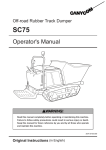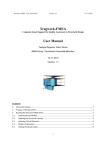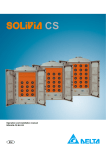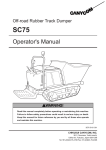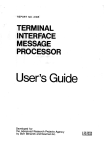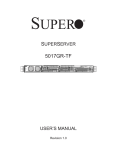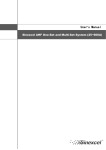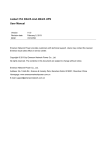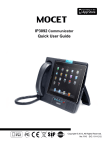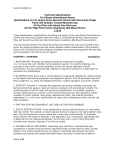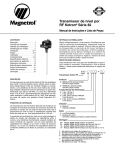Download UPS NS3000 10-20
Transcript
NS3000 Series User Manual Rev. 01 NS3000 Series User Manual UPS NS3000 10-20-30kVA USER Manual -1- -2- Rev. 01 NS3000 Series User Manual Rev. 01 NS3000 Series User Manual Components that can be maintained by user Safety Precautions This manual is about the installation and operation of NS3000 Series UPS (Hereinafter referred to as UPS). Please carefully read this manual prior to installation. The UPS must be debugged and maintained by the engineer commissioned by the manufacturer or the agent. Otherwise, human safety may be endangered and the damage of UPS shall not belong to the warranty scope. UPS is only used for commercial / industrial purpose and cannot be used as power of life support equipment. All the equipment maintenance and servicing procedures involving internal access need special tools and should be carried out only by trained personnel. The components that can only be accessed by opening the protective cover with tools cannot be maintained by user. This UPS full complies with “IEC62040-1-1-General and safety requirements for use in operator access area UPS”.Dangerous voltages are present within the battery box. However, the risk of contact with these high voltages is minimized for non-service personnel. Since the component with dangerous voltage can only be touched by opening the protective cover with a tool, the possibility of touching high voltage component is minimized. No risk exists to any personnel when operating the equipment in the normal manner, following the recommended operating procedures in this manual. APPLICABLE STANDARDS Battery Voltage Higher Than 400Vdc This product complies with 2006/95/EC - CE 73/23 & 93/68 (low voltage safety) and 2004/108/EC 89/336 (EMC) , and EMC standards of Australia and New Zealand (C-Tick) , and the following UPS product standards: *IEC62040-1-1-General and safety requirements for use in operator access area *IEC/EN62040-2 EMC requirements CLASS C3 *IEC62040-3 Performance requirements and test methods Continued compliance requires installation in accordance with these instructions and the use of manufacturer approved accessories only. All the battery maintenance and servicing procedures involving internal access need special tools or keys and should be carried out only by trained personnel. SPECIAL CARE SHOULD BE TAKEN WHEN WORKING WITH THE BATTERIES ASSOCIATED WITH THIS EQUIPMENT. WHEN CONNECTED TOGETHER, THE BATTERY TERMINAL VOLTAGE WILL EXCEED 400Vdc AND IS POTENTIALLY LEATHAL. Battery manufacturers supply details of the necessary precautions to be observed when working on, or in the vicinity of, a large bank of battery cells. These precautions should be followed implicitly at all times. Particular attention should be paid to the recommendations concerning local environmental conditions and the provision of protective clothing, first aid and fire-fighting facilities. WARNING- High earth leakage current Earth connection is critical before connecting the input supply (include both utility supply and battery) . This equipment must be earthed in accordance with local electrical authority codes of practice. Earth leakage current exceeds 3.5 mA and is less than 1000 mA. Transient and steady-state earth leakage currents, which may occur when starting the equipment, should be taken into account when selecting instantaneous RCCB or RCD devices. Residual Current Circuit Breakers ( RCCBs) must be selected insensitive to DC unidirectional pulses ( class A ) and transient current pulses ( RCCBs) . Note it that the earth leakage currents of the load will also flow across UPS RCCB or RCD. Warning: Back feed Protection Backfeed protection, (optional), is provided to isolate the static switch if excessive voltage is present at the bypass input when the bypass source is deenergized. If this function is not installed and enabled , there must be a warning label on the external bypass switch to remind the operator of the connection. The warning on label should be: Isolate the UPS before operating this part. -3- -4- Rev. 01 NS3000 Series User Manual rev.01 CONTENTS Chapter 1 Quick Start .................................................................................. 8 1.1 Introduction ................................................................................................................................................... 8 1.2 Initial Checking.............................................................................................................................................. 8 1.3 Environment Checking ................................................................................................................................... 8 1.4 Installation Checking...................................................................................................................................... 8 Chapter 2 Installation Guidance ................................................................... 9 2.1 Introduction ................................................................................................................................................... 9 2.2.2 Battery Room ................................................................................................................................10 2.2.3 Storing ..........................................................................................................................................10 2.3 Disassembly, Initial Checking and Positioning .............................................................................................. 10 2.3.1 System Packing .............................................................................................................................10 2.3.1.1 Remove the ups from the pallet .................................................................................................11 Fig 2-1 UPS Packing Diagram ................................................................... 11 3.2.3 Auto-Restart Mode ........................................................................................................................29 3.2.4 Bypass Mode.................................................................................................................................29 3.2.5 Maintenance Mode ........................................................................................................................29 3.2.6 ECO Mode ....................................................................................................................................29 3.2.7 Frequency Converters Mode ..........................................................................................................29 3.2.8 Parallel connection redundancy mode.............................................................................................30 3.3 Battery Management .................................................................................................................................... 30 3.3.1 Normal Function ...........................................................................................................................30 3.3.2 Advanced Functions (Battery Self-checking and Maintenance) .......................................................30 3.4 Battery Protection ........................................................................................................................................ 30 Chapter 4 Installation of Parallel Operation System .................................... 31 Chapter 5 Operating Procedures................................................................ 33 5.1 Power Switches............................................................................................................................................ 33 5.2 UPS Start-up ................................................................................................................................................ 33 2.3.2 UPS Composition..........................................................................................................................12 5.2.1 Normal Mode Start ........................................................................................................................33 2.3.3 Operation Space ............................................................................................................................12 5.2.2 Battery Module Start (Only Applicable for the UPS with Battery Cold Start Elements) ..............35 2.3.4 Front and Back Access...................................................................................................................12 5.3 Procedure for Switching between Operation Modes....................................................................................... 35 2.3.5 Final Positioning ...........................................................................................................................12 5.3.1 Procedure for Switching the UPS into Battery from Normal Mode ..................................................35 2.3.6 Cable Entry ...................................................................................................................................12 5.3.2 Procedure for Switching the UPS into Bypass from Normal Mode ..................................................35 2.4 Protective Devices........................................................................................................................................ 12 5.3.3 Procedure for Switching the UPS into Normal from Bypass Mode ..................................................36 2.4.1.1 Rectifier and Bypass Input Supply of the UPS .............................................................................13 5.3.4 Procedure for Switching the UPS into a Maintenance Bypass from Normal Mode ...........................36 2.4.1.2 Beakfeed Protection. ................................................................................................................14 5.3.5 Procedure for Switching the UPS into Normal from a Maintenance Bypass Mode ...........................36 2.4.3 Battery ..........................................................................................................................................15 2.5.1 Maximum stable state current and configuration of minimum cable system .....................................15 5.4 Procedure for Completely Powering down a UPS.......................................................................................... 36 5.5 EPO Procedure............................................................................................................................................. 37 5.6 Language Selection ...................................................................................................................................... 37 5.7 Control Password ......................................................................................................................................... 37 2.5.2 Cable Connection ..........................................................................................................................16 Chapter 6 Operator Control and Display Panel ........................................... 38 2.4.3 UPS Output ...................................................................................................................................15 2.5 Power Cables ............................................................................................................................................... 15 2.5.3 Connection for Battery...................................................................................................................17 2.6 Control and Communication Cabling ............................................................................................................ 20 2.6.1 Dry Contact Interface of Battery and Environmental Temperature Detection (Optional)...................20 2.6.2 Remote EPO Input Port (Optional) .................................................................................................21 2.6.3 Generator Input Dry Contact (Optional) .........................................................................................22 2.6.4 BCB Interface (Optional) ...............................................................................................................22 2.6.5 Battery Warning Output Dry Contact Interface (Optional)...............................................................23 2.6.6 General Warning Output Dry Contact Interface (Optional)..............................................................23 2.6.7 Mains Failure Warning Output Dry Contact (Optional) ...................................................................24 2.6.8 RS232-RS485 Port and SNMP Card Port .......................................................................................24 2.7 Installation Diagram .................................................................................................................................. 25 Chapter 3 Operations ................................................................................ 27 3.1 Introduction ................................................................................................................................................. 27 3.1.1 Principle........................................................................................................................................27 3.1.2 Bypass ..........................................................................................................................................28 3.1.3 Battery Temperature Compensation ...............................................................................................28 3.2 Operation Mode ........................................................................................................................................... 28 3.2.1 Normal Mode ................................................................................................................................29 3.2.2 Battery Mode ................................................................................................................................29 6.1 Introduction ................................................................................................................................................. 38 6.1.1 LED Indicator ...............................................................................................................................39 6.1.2 Audible Alarm (buzzer) .................................................................................................................39 6.1.3 Functional Keys ............................................................................................................................40 6.2 LCD Display Type ....................................................................................................................................... 40 6.2.1 Default Display .............................................................................................................................40 6.2.2 Data Display..................................................................................................................................40 6.2.3 Setting Display ..............................................................................................................................41 6.2.4 Function Display ...........................................................................................................................41 6.2.5 State Display .................................................................................................................................41 6.2.6 Confirm Display ............................................................................................................................42 6.2.7 History Record Display..................................................................................................................42 6.3 Detailed Description of Menu Items.............................................................................................................. 43 6.4 Alarm List ................................................................................................................................................... 44 Chapter 7 Maintenance.............................................................................. 45 7.1 Instruction of Maintenance Operation ........................................................................................................... 45 7.1.1 Precautions....................................................................................................................................45 7.1.2 Instruction to Bypass Module.........................................................................................................45 Chapter 8 Product Specification ................................................................. 46 8.1 Applicable Standards.................................................................................................................................... 46 -5- -6- NS3000 Series User Manual rev.01 NS3000 Series User Manual rev.01 8.2 Environmental Characteristics ...................................................................................................................... 46 Table 8-2........................................................................................................................................................... 46 8.3 Mechanical Characteristics ........................................................................................................................... 46 8.4 Electrical Characteristics (Input Rectifier)..................................................................................................... 47 8.5 Electrical Characteristics (Intermediate DC Link).......................................................................................... 47 8.6 Electrical Characteristics (Inverter Output).................................................................................................... 48 8.7 Electrical Characteristics(Bypass Mains Input).............................................................................................. 49 8.8 Efficiency .................................................................................................................................................... 49 Chapter 1 Quick Start 1.1 Introduction This chapter introduces the basic principles for UPS installation and debugging, so that personal service can install and debug UPS quickly. 1.2 Initial Checking Perform the following checking operations prior to the UPS installation. 1. Visually examine if there is any damp, water, or damage inside and outside the UPS packing, products and battery equipments due to the transportation. Report any such damage to the shipper immediately. 2. Verify the product label and confirm the correctness of the equipment. The equipment label is attached on the panel behind front door. The UPS model, capacity and main parameters are marked on the label. 3. Verify correctness of the accessories. If there is any mistake for accessories, contact with shipper or provider. 1.3 Environment Checking Before installing UPS, please check these items as below: 1. Is the UPS operation environment temperature above 25°C? If so, please add cooling equipments. Note: Environment temperature above 20°C, battery life will reduce to half when environment rise each 10°C. temperature 2. Is the UPS operation environment temperature below 0°C? If so, please add heaters. 3. Is the UPS operation environment humidity is above 90% Is there any condensing? If so, please add additional protection. 4. In the UPS operation environment, is there any sunshine shining in directly or life-form coming in? If so, please add additional protection. 5. In the UPS operation environment, is there any dust, combustible or explosive gas? If so, please add additional protection. 1.4 Installation Checking After finishing installation, please check these items as below: -7- 1. Is UPS installed on the flame-retardant materials? 2. Are all cables connected exactly? 3. Are all grounded system connected according to the manual? 4. Is there enough operation space around UPS? 5. Please confirm all UPS external terminals are fastened, the moment should meet requirements. 6. Please confirm that there are no screws, cables and other conductor left in the UPS. If there is, please take out. -8- NS3000 Series User Manual rev.01 NS3000 Series User Manual rev.01 2.2.2 Battery Room Chapter 2 Installation Guidance 2.1 Introduction This chapter introduces UPS installation, it provide normal installation steps and ideas. Please installation engineers operate according to each place difference, Warning-Installation can only be done by authorized engineers 1. Do not apply electrical power to the UPS equipment before the approval of commissioning engineer. 2. The UPS should be installed by a qualified engineer in accordance with the information contained in this chapter. The battery will generate some amount of hydrogen and oxygen at the end of charging, so the fresh air volume of the battery installation environment must meet EN50272-2001 requirements. The ambient temperature of the battery must be stable. Ambient temperature is a major factor in determining the battery capacity and life. The nominal operating temperature of battery is 20°C. Operating above this temperature will reduce the battery life, and operation below this temperature will reduce the battery capacity. If the average operating temperature of battery is increased from 20ºC to 30ºC, then the service life of the battery will be reduced by 50%. If the operating temperature of the battery is above 40ºC, then the battery service life will be decreased in exponent rate. In a normal installation, the battery temperature is maintained between 15°C and 25°C. Keep batteries away from heat sources or air outlets. If external batteries are to be used, a battery protection device (a DC circuit breaker) must be mounted as close as possible to the batteries, and the connecting cables should be as short as possible. 2.2.3 Storing If the equipment not be installed immediately, it must be stored in a room so as to protect it against excessive humidity and heat sources. The battery needs to be stored in dry and cool place with good ventilation. The most suitable storage temperature is 20 ºC to 25ºC. Note: 3-Phase 4-Wire Input Power is required 2.3 Disassembly, Initial Checking and Positioning The standard UPS can be connected to TN, TT AC distribution system (IEC60364-3) of 3-phase 5-wire.For IT system please contact us. WARNING: battery hazards SPECIAL CARE SHOULD BE TAKEN WHEN WORKING WITH THE BATTERIES ASSOCIATED WITH THIS EQUIPMENT. When connecting the battery, the battery terminal voltage will exceed 400Vdc and is potentially lethal. l Eye protection should be worn to prevent injury from accidental electrical arcs. l Remove rings, watches and all metal objects. l Only use tools with insulated handles. l Wear rubber gloves. l If a battery leaks electrolyte, or is otherwise physically damaged, it must be replaced, stored in a container resistant to sulfuric acid and disposed of in accordance with local regulations. l If electrolyte comes into contact with the skin, the affected area should be washed immediately with water. Check the packaging first upon the arrival of product to see if there is any damage; open the packaging to check the equipment; report any such damage to the shipper immediately. 2.3.1 System Packing Remove the carton box and the plastic film first, thensee.Durig the procedure under descript scratch the product. 2.2.1 Distribution Room The UPS is designed for indoor installation, which shall be located in a clean environment with adequate ventilation to keep the environmental temperature within the required specification. The UPS uses forced convection cooling by internal fans. Cooling air enters the module through ventilation grills located at the front part or in front and botton (NS3030) of the cabinet and exhausted through grills located in the rear part of the cabinet. Please do not block the ventilation holes. If necessary, a system of extractor fans should be installed to aid cooling-air flow. An air filter should be used when the UPS is to operate in a dirty environment and should be regularly cleaned to maintain airflow. Note: The UPS should be installed on a cement surface or other surface that is not combustible. -9- -10- Be careful not NS3000 Series User Manual rev.01 NS3000 Series User Manual rev.01 REMOVING THE UPS FROM THE PALLET Verify the product label and confirm the correctness of the equipment. The equipment label is attached on the back of front door. The UPS model, capacity and main parameters are marked on the label. Warm Tips: Please dispose the wasted materials in accordance with environmental protection requirements after disassembly. Fig 2-1 UPS Packing Diagram To prolong the service life, the place chosen for the UPS must guarantee: CAUTION! TO AVOID HARMING PEOPLE AND/OR DAMAGING THE EQUIPMENT, FOLLOW CAREFULLY THE FOLLOWING INSTRUCTIONS. SOME OF THESE INSTRUCTIONS NEED TO BE CARRIED OUT BY TWO PEOPLE. l Easy wiring l Sufficient space for operation l Air sufficient enough to dispel heat produced by UPS l Against ambient corrosive gases l Against excessive humidity and heat sources l Against dust l With the current fire prevention requirements l The operating environment temperature is within 20 -25 . The batteries are at maximum efficiency in this temperature range (for information about the battery storage and transportation as well as the environment, please refer to table 8-2) 2.3.2 UPS Composition Cut the straps and remove the cardboard box by sliding it upwards. § Remove the 2 brackets securing the UPS to the pallet by unscrewing the screws. 10KVA~30KVA cabinet 2.3.3 Operation Space As UPS has no ventilation grills at either side, no clearances are required for the sides. To enable routine tightening of power terminations within the cabinet, it is recommended that clearance around the front and back of the equipment should be sufficient to enable free passage of personnel with the doors fully opened. The back door of the cabinet is more than 800mm from the wall or other cabinets. Distance from the back ≥ 200mm § The previously removed brackets can also be used as slides. Secure the slides to the pallet by using the type A screws, making sure they are aligned with the wheels. 2.3.4 Front and Back Access The component layout of the UPS supports front and back access for servicing, diagnosing and repairing the UPS, thus reducing the space requirement for side access. 2.3.5 Final Positioning When the equipment has been finally positioned, ensure the adjustable feet is set so that the UPS will remain stationary and stable. 2.3.6 Cable Entry A lower incoming line is used for 10KVA~30KVA UPS. 2.4 Protective Devices § § § Screw the brake rod completely, so to separate it from the pallet Make sure that the door is firmly closed. CAUTION! Push the UPS from the rear with great care. Given the weight of the equipment, this operation needs to be carried out by two peopleNOTE : It is recommended to keep all parts of the packaging for further use For safety concerns, it is recommended to install external circuit breakers or other protective devices for the input AC supply of the UPS system. We suggest to choose the input automatic break Bigger than internal automatic Breaker and D curve for the selectivity with internal UPS protection. This section provides generic practical information for qualified installation engineers. The installation engineers should have the knowledge of the regulatory wiring standards, and of the equipment to be installed. Tip: Dismantle the bolts that connect the cabinet and wooden pallet after disassembly, then lift the cabinet to installation position. The dismantlement should be careful so as not to scratch the body. -11- -12- NS3000 Series User Manual rev.01 NS3000 Series User Manual rev.01 2.4.1.1 Rectifier and Bypass Input Supply of the UPS 2.4.1.2 Backfeed Protection. Install suitable protective devices in the distribution unit of the incoming mains supply, considering the power cable current-carrying capacity and overload capacity of the system. Generally, the magnetic circuit breaker with IEC60947-2 tripping curve C (normal) at the 125% of the current listed in table 2-1 is recommended. Whith common input we suggest tripping curve d Put a label on all primary power isolators installed remote from the UPS area. One label is supply Before working on this circuit - Isolate Uninterruptible Power System (UPS) Note - Then check for Hazardous Voltage between all terminals For IT power network system, 4-pole protective device must be installed on the external input distribution of the UPS. including the protective earth Earth leakage current If protection against earth faults (RCD devices) is required for the upstream of the input supply, the installed device should: l Sensitive to DC Class B or class A Risk of Voltage Backfeed in the network UPS whit by-pass and line input separate l Insensitive to transient current pulses l Have an average sensitivity that is adjustable between 0.3A-1A Customer distribution UPS Imput terminal Q L2 L1ma L2 mb L3 L3mc L1 N N Q Byp. terminal T1 L1 ba L11 L21 L2 bb L31 L3bc N N1 UPS whit by-pass and line input common UPS Customer distribution Q UPS Input teminals T1 L11 L1 ba L1ma L21 L2 L2 mb L31 L3bc L3mc N1 N N Pay attention Neutral is common point inside UPS. -13- -14- NS3000 Series User Manual rev.01 NS3000 Series User Manual rev.01 Warning 2.4.3 Battery A battery string is composed of 40 batteries connected in series, maximum is possible install 2 strings 40batteries (B1-B2 in this document). The positive, the negative and middle point (the joint part between the 20th and 21st battery) cable must push through a DC circuit breaker before connecting to corresponding UPS . For detailed wiring please refers to fig 2-4 below: FAILURE TO FOLLOW ADEQUATE EARTHING PROCEDURES CAN RESULT IN EMI, ELECTRIC SHOCK HAZARD OR RISK OF FIRE, SHOULD AN EARTH FAULT OCCUR. 2.5.2 Cable Connection Important The operations described in this section must be performed by authorized electricians or qualified technical personnel.. If you have any difficulties, do not hesitate to contact our Customer Service & Support department . Batt- Batt + Batt + Batt - N Batt - After the equipment has been finally positioned and secured, connect the power cables as described in the following procedures: 1. Verify that all the external input distribution switches of the UPS are completely opened (off position) and the UPS internal maintenance bypass switch is opened. Attach necessary warning signs to these switches to prevent unauthorized operation. 2. Open the door of the cabinet, remove the left bottom cover and then the input and output terminal, battery terminal and earth terminal are visible. 3. Connect the input earth wire to input earth terminal. Please note: the earth wire shall be connected in accordance with related local or state regulation 4. If in UPS, same electric supply input is used for the by-pass and main input AC input cables should be connected Forty batteries in series connection in total B1 + series B1 - series Fig 2-4 Diagram of batteries connected in series 2.4.3 UPS Output with the input terminal of UPS (Main input L1ma – L2mb – L3mc and the output load cables are connected with the output terminal of UPS (Output L1oa - L2oA - L3oC). If in UPS, two electric supply inputs are used for A main output switch has been installed in UPS; the user shall install the overcurrent protective device on the bypass and on each output of the external distribution cabinet. the rectifier and by-pass, the AC input cables should be respectively connected with the main input terminal of UPS (Main input L1ma - L2mb – L3mc and the input terminal of the bypass,L1ba,L2bb,L3bc and the short circuit copper bars between the main circuit and the bypass have to be removed; fastening moment of force is 2.5 Power Cables Design the cables according to the descriptions in this section and local regulatory wiring standards, and the environmental conditions should be taken into consideration. Refer to IEC60950-1 table 3B. 30kg(M5), 50kg(M6), 180kg(M8). Attention is given to phase sequence and the short circuit at a joint between cable terminals. If the phase sequence is wrong UPS show an alarm 5. Connect the battery cables between the UPS battery terminals and battery switch. ENSURE CORRECT Polarity. Warning Warning-Hazardous battery terminal voltage ≥400Vdc Prior cabling the UPS, confirm the status and positions of the switches of the UPS rectifier input power supply / bypass power supply and mains power distribution board. Ensure that these switches are opened and attached with WARNING label so as to prevent unauthorized operation to these switches. The operations described in this section must be performed by authorized electricians or qualified technical personnel. Ensure the correct polarity connection between the battery terminals and the UPS terminals: Positive terminal to positive terminal, negative terminal to negative terminal, The middle poin of the batteies is Neutral point in the UPS. Disconnect in the tray 1 and tray 5 the cable marked A and B. Do not connect the cables and close the battery circuit breakers before getting the approval from the commissioning engineer. 2.5.1 Maximum stable state current and configuration of minimum cable system Table 2-1 Model Name NS3010 NS3020 NS3030 UPS Power 10KVA 20KVA 30KVA Rated current A 15A 30A 45A Cable mm2 4 6 10 Output Rated current A 15A 30A 45A Cable mm2 4 6 10 Battery Rated current A 18A 36A 53A Cable mm2 6 10 16 PE Cable mm2 4 10 10 Main Input -15- 6. Re-install all the protective covers. -16- NS3000 Series User Manual rev.01 NS3000 Series User Manual rev.01 Legend fig. 2.5A 2.5.3 Connection for Battery B1 On NS3000 10-30kVA series UPS, there is an internal battery breaker in the UPS. Also, this type UPS offer external battery connection terminals. If customers want to use external battery, they have to install a battery breaker or fuse between the UPS and the external battery. UPS can have one ore two string of batteries B1 or B1+B2 each string is composed with 20+20 Battery with common point see table 1. UPS B1 B1+B2 NS3010 40*7 or 9A/h 2*40*7 or 9A/h NS3020 40*7 or 9A/h 2*40*7 or 9A/h NS3030 ---------- B2 first string 40 battery with common point Second string 40 batteries with common point BAT – Mark NEGATIVE cable 40 battery series output BAT+ Mark on POSITIVE cable 40 battery series output BATT -.N Common point 40 batteries series C Batteries cable A Mark on positive cable out put 8 or 4 series batteries B Mark on negative out put 8 or4 series batteries 2*40*7 or 9A/h FIG.2.5.A FRONT VIEW AND BATTERY CONNECTION Tab.1 The method of build-in battery connection as shown fig. 2-5: Warning-Hazardous battery terminal voltage ≥400Vdc THE BATTERIES MUST BE INSTALLED WITH THE ORIGINAL MANUFACTORY KIT THAT INCLUDE THE DEDICATE PLASTIC BATTERY BOX. KIT CABLE cod. KITNS-CAVBATINT USE THE MANUFACTORY INSTRUCTION. 2.5.3.1 UPS arrives with out batteries Instructions for forty batteries 1) Opend the battery breaker 2) Insert the batteries in the plastic box and connect the batteries according fig. 2.5.B 3) Check with the multimeter the battery output cable correct polarity and voltage ( 8 battery have to be about 101-104V, 4 battery ave to be about 50-52V) 4) Fix the plastic battery box with hard tape at least in 2 positions. 5) Insert the plastic battery box according fig. 2.5.A. Pay attention all cable are marked and have different color. 6) Connect the battery according fig 2.5.A , don’t connect A and B cable in the shelf 1 7) In shelf 1 on the left connect the cable mark A with the cable mark B on shelf 2 8) Check B1- negative battery voltage on battery breaker. Negative battery is on the battery breaker right lower terminal, the neutral is on the battery breaker central lower terminal. 9) With 20 batteries the voltage is NEGATIVE, about - 255 /-260V 10) In the shelf 1 (B1+) on the right connect the cable mark A with the cable mark B on shelf 2 11) Check B1+ positive battery voltage on battery breaker. Positive battery is on the battery breaker left lower terminal, the neutral is on the battery breaker central lower terminal. 12) With 20 batteries the voltage is POSITIVE about + 255 -260V Impotant: with 80 batteries repeat the operation upper descript change layer1 with layer 5 and B1 with B2 , with B1 battery block don’t connect 2.5.3.2 UPS arrived with batteries inside Start from point 6 to to 2.5.3.1 UPS arrives with out batteries section. -17- -18- NS3000 Series User Manual rev.01 NS3000 Series User Manual rev.01 TOP VIEW INTENAL SHELF BATTERY POSITION 2.6 Control and Communication Cabling fig. 2-6 shown, the Relay card dry contact interface (J2-J10), communication interface (RS232 interface, 485 interface and SNMP card interface) and parallel card position. FIG.2.5.B Fig 2-6 Dry contact interface and communication interface The UPS accepts external signal from zero-voltage (dry) contacts connected through external dry contact terminals produced and phoenix terminals. Through software programming, these signals become active when these contacts connect to +24V to ground.The cables connected to DRY terminal must be separated from power cables. Moreover, these cables should be double insulated with a typical 0.5 to 1.5 mm2 cross-section area for a maximum connection length between 25 and 50 meters. 2.6.1 Dry Contact Interface of Battery and Environmental Temperature Detection (Optional) The input dry contact J2 and J3 can detect the temperature of batteries and environment respectively, which can be used in environment monitoring and battery temperature compensation 1. J2 and J3 interfaces diagram are shown in fig 2-7, the description of interface is in table 2-2. J2 J3 Fig 2-7 Diagram of J2 and J3 dry contact for temperature detecting Table 2-2 Position J2.1 J2.2 J3.1 J3.2 Name TEMP_BAT GND TEMP_ENV GND Purpose Battery temperature detection Power ground Environment temperature detection Power ground Note: Specified temperature sensor is required for temperature detection (R25=5kOhm, B25/50=3275), please confirm with the manufacturer, or contact local maintenance engineers when placing an order. I -19- -20- NS3000 Series User Manual rev.01 NS3000 Series User Manual rev.01 2.6.2 Remote EPO Input Port (Optional) 2.6.3 Generator Input Dry Contact (Optional) The UPS has an Emergency Power OFF (EPO) function. This function can be activated by pressing a button on the control panel of the UPS or through a remote contact provided by the user. The EPO pushbutton is protected by a hinged plastic cover. J4 is the input port for remote EPO. It requires shorting NC and +24v during normal operation, and the EPO is triggered when opening NC and +24v, or shorting NO and +24v. The port diagram is shown in Fig 2-8, and port description is shown in table 2-3. J5 is status interface for generator connection. Connect pin 2 of J5 with + 24V power supply, and it indicates that the generator has been connected with the system. The interface diagram is shown in fig 2-9 and interface description is shown in table 2-4 +24V J4 Generator Fig 2-8 Diagram of input port for remote EPO Fig 2-9 Diagram of status interface and connection of generator Table 2-3 Description of input port for remote EPO Position J4.1 Name EPO_NC Purpose EPO is activated when disconnecting fromJ4.2 J4.2 +24V +24V, connect the common terminal of NC and NO J4.3 EPO_NO EPO is activated when shorting with J4.2 If an external emergency stop facility is required, it is connected via the reserved terminals of J10.The external emergency stop facility needs to use shielded cables to connect to the `normally open/closed remote stop switch between these two pins. If this facility is not used, then pin 2 and pin 3of J4 must be open, or pin 1 and pin 2 of J4 must be shorted. Table 2-4 Position J5.1 J5.2 J5.3 Name +24V GEN GND Purpose +24V power supply Connection status of generator Power ground 2.6.4 BCB Interface (Optional) J6 and J7 are battery circuit breaker (BCB) interface. The interface diagram is shown in fig 2-10 and interface description is shown in table 2-5. Note BCB_ONL BCB_CON T BCB_DRV 1. The emergency stop action within the UPS will shut down the rectifier, inverter and static bypass. However, it does not internally disconnect the mains input and batterypower supply. To disconnect ALL power to the UPS, open the upstream input circuit breaker(s) and battery breakerwhen the EPO is activated. 2. Pin 1 and 2 of J4 have been shorted before the UPS is delivered Fig 2-10 BCB Interface Table 2-5 Position J6.1 -21- Name BCB_DRV J6.2 BCB_CONT J7.1 GND J7.2 BCB_ONL Purpose BCB drive signal: providing +24V, 20mA drive signal BCB contact status,connect to BCB’s normal open signal Power ground BCB online input(normal open),it shows BCB is online when this signal connects to GND. -22- 2.6.7 Mains Failure Warning Output Dry Contact (Optional) J8 is the output dry contact interface, which indicate the battery warnings of low or excessive voltage, when the battery voltage is lower than set value, an auxiliary dry contact signal will be provided. The interface diagram is shown in fig 2-11, and description is shown in table 2-6. J10 is the output dry contact interface for mains failure warning, when the mains fails, the system will send a mains failure warning information.. The interface diagram is shown in fig 2-13, and description is shown in table 2-8. GND 2.6.5 Battery Warning Output Dry Contact Interface (Optional) BAT_LOW_NO NS3000 Series User Manual rev.01 BAT_LOW_NC NS3000 Series User Manual rev.01 Fig 2-13 Mains failure warning dry contact diagram Table 2-8 Fig 2-11 Battery warning dry contact interface diagram Table 2-6 Position J8.1 J8.2 J8.3 Name BAT_LOW_NC BAT_LOW_NO GND Purpose Battery warning relay (normally closed) will be open during warning Battery warning relay (normally open) will be closed during warning Center of battery warning relay common 2.6.6 General Warning Output Dry Contact Interface (Optional) J9 is the genera warning output dry contact interface, when one or more than one warning is triggered, the system will send integrated warning information, and provide an auxiliary dry. The interface diagram is shown in fig 2-12, and description is shown in table 2-7 Position Name Purpose J10.1 UTI_FAIL_NC Mains failure warning relay(normally closed) will be open during warning J10.2 UTI_FAIL_NO Mains failure warning relay( normally open) will be closed during warning J10.3 GND Centre of mains failure warning relay common 2.6.8 RS232-RS485 Port and SNMP Card Port RS232 and RS485 Port: provide serial data which can be used for commissioning and maintenance by authorized engineers or maintainers, or can be used for networking or integrated monitoring system in the service room. SNMP Card Port: used for field installation of the communication option card (SNMP card). GND ALARM_NO ALARM_NC J9 Fig 2-12 General warning dry contact interface diagram Table 2-7 Position J9.1 J9.2 J9.3 Name Purpose ALARM_NC Integrated warning relay (normally closed) will be open during warning ALARM_NO Integrated warning relay (normally open) will be closed during warning GND Centre of integrated warning relay -23- -24- NS3000 Series User Manual rev.01 NS3000 Series User Manual rev.01 2.7 Installation Diagram NS3010 NS3020 NS3030 a. 10KVA~30KVA terminal block -25- -26- NS3000 Series User Manual rev.01 NS3000 Series User Manual rev.01 3.1.2 Bypass Chapter 3 Operations This chapter introduces the basic knowledge of UPS operations, including working principle, operation mode, battery management and protection. . During normal system operation the load is connected to the inverter; but in the event of a UPS overload or inverter failure, the load is automatically transferred to the static bypass line. To provide a clean (no-break) load transfer between the inverter output and static bypass line, the inverter output and bypass supply must be fully synchronized during normal operating conditions. This is achieved through the inverter control electronics, which makes the inverter frequency track that of the static bypass supply, provided that the bypass remains within an acceptable frequency window. A manually controlled maintenance bypass supply is incorporated into the UPS design. It enables the critical load to be powered from the utility (bypass) supply while the UPS is shut down for routine maintenance. Warning: Hazardous mains voltage and/or battery voltage present(s) behind the Note protective cover 1.The components that can only be accessed by opening the protective cover with tools cannot be When the UPS is operating in bypass mode or on maintenance bypass, the connected equipment is operated by user. not protected from power failures or surges and sags。 2.Only qualified service personnel are authorized to remove such covers. 3.1.3 Battery Temperature Compensation 3.1 Introduction UPS provides high quality uninterruptible AC power to your critical load. The power from UPS is free from voltage and frequency variations and disturbances (interruption and spike) experienced at the Mains AC input supply. The UPS can connect temperature sensor which is in the battery cabinet to the UPS monitor unit through battery temperature interface in order to reach battery management optimization. This is achieved through high frequency double conversion power pulse width modulation (PWM) associated with full digital signal processing control (DSP), which features high reliability and convenience for use. 3.1.1 Principle As shown in fig 3-1, the AC input mains source is supplied at UPS input and converted into a DC source. This DC source feeds the Inverter that converts the DC source into a clean and input independent AC source. The battery powers the load through the inverter in case of an AC input mains power failure. The utility source can also power the load through the static bypass. When the UPS needs maintenance or repair, the load can be transferred to maintenance bypass without interruption and the power module and bypass module can be removed for maintenance. Fig 3-2 Temperature compensation diagram 3.2 Operation Mode NS3000 is an on-line, double-conversion UPS that permits operation in these modes: l Normal mode l Battery mode l Auto-Restart mode l Bypass mode l Maintenance mode (manual bypass) l ECO mode Fig 3-1 System principle framework -27- (Settable by s.w.) l Frequency converters mode ( only to request) l Parallel operation redundancy mode (Optional) -28- NS3000 Series User Manual rev.01 NS3000 Series User Manual rev.01 3.2.1 Normal Mode 3.2.8 Parallel connection redundancy mode The UPS inverter power modules continuously supply the critical AC load. The rectifier/charger derives power from the AC mains input source and supplies DC power to the inverter while simultaneously FLOAT or BOOST charging its associated backup battery. devices ensures all single device automatically share the load to improve the capacity or reliability of the system, or both 3.2.2 Battery Mode Several UPS devices may be parallel connected directly and the parallel operation control logic in single UPS the capacity and reliability of the system. The capacity of a parallel operation system can be up to 6 units. 3.3 Battery Management Upon failure of the AC mains input power; the inverter power modules, which obtains power from the battery, supplies the critical AC load. There is no interruption in power to the critical load upon failure. After restoration of the AC mains input power, the “Normal Mode” operation will continue automatically without the necessity of user intervention. Note: UPS can also be started through battery mode via battery cold start function upon failure of the AC mains. Therefore, the battery power can be used independently to improve the utilization rate of UPS. 3.3.1 Normal Function The following functions should be fitted by commissioning engineers with specified software. 1. Constant current boost charging Current can be set up 3.2.3 Auto-Restart Mode 2. The battery may become exhausted following an extended AC mains failure. The inverter shuts down when the battery reaches the End of Discharge voltage (EOD). The UPS may be programmed to “Auto Recovery after EOD” after a delay time if the AC main recovers. This mode and any delay time are programmed by the commissioning engineer. During the process of delay time, the battery will be charged by UPS to prevent any risks to load equipment from future mains failure. Constant voltage boost charging Voltage of boost charging can be set as required by the type of battery. For Valve Regulated Lead Acid (VRLA) batteries, maximum boost charge voltage should not exceed 2.4V / cell. 3. Float charge Voltage of float charging can be set as required by the type of battery. For VRLA, float charge voltage should be between 2.2V to 2.3V. 3.2.4 Bypass Mode 4. If the inverter overload capacity is exceeded under normal mode, or if the inverter becomes unavailable for any reason, the static transfer switch will perform a transfer of the load from the inverter to the bypass source, with no interruption in power to the critical AC load. 5. 3.2.5 Maintenance Mode A coefficient of temperature compensation can be set as required by the type of battery. 6. Warning: Hazard may occur after transferring to maintenance bypass Battery low warning time It is adjustable between 3 and 60 minutes. The default is 5 minutes. 3.3.2 Advanced Functions (Battery Self-checking and Maintenance) At periodic intervals, 20% of the rated capacity of the battery will be discharged automatically, and the actual load must exceed 20% of the rated UPS (KVA) capacity. If the load is less than 20%, auto-discharge cannot be executed. The periodic interval can be set from 30 to 360 days. The battery self-test can be disabled. After UPS being transferred to maintenance bypass, UPS battery, input and output terminals and are charged. 3.2.6 ECO Mode End of discharge (EOD) protection. If the battery voltage is lower than the EOD, the battery converter will shut down and the battery is isolated to avoid further battery discharge. EOD is adjustable from 1.6V to 1.75V per cell (VRLA) or 0.9 to 1.1 V per cell A manual bypass switch is available to ensure continuity of supply to the critical load when the UPS becomes unavailable e.g. during a maintenance procedure. It is noticed that after UPS system supplies the power with the bypass mode, the maintenance bypass rotary switch Q3, in this situation is closed Q1, Q2, Q3-2 out put contacts and battery switches are disconnected. Float charge temperature compensation (optional) Conditions—Battery at float charge for at least 5 hours, load equal to 20~100% of rated UPS capacity Trigger—Manually through the command of “Battery Maintenance Test” in LCD panel or automatically 3.4 Battery Protection If economical (ECO) mode is selected, the double-conversion UPS will stop to work so as to save energy. During the operation of ECO mode, the load power will be supplied by bypass preferentially. When bypass power is within the range of normal frequency and voltage, load power will be supplied by bypass, or the system will transfer to inverter output, followed by load power interruption which extends within 3/4 of the period. E.g. when the frequency is 50Hz, the interruption time will be less than 15ms; when the frequency is 60Hz, the time will be less than 12.5ms. Eco mode have to set by customer service The following functions should be fitted by commissioning engineers with specified software. 1. Battery Low Pre-warning The battery undervoltage pre-warning occurs before the end of discharge. After this pre-warning, the battery should have the capacity for 3 remaining minutes discharging with full load. The time is user configured from 3 to 60 minutes. 2. Battery discharge (EOD)off protection If the battery voltage is lower than the EOD, the battery converter will be shut down. EOD is adjustable from 1.6V to 1.75V per cell (VRLA) or 0.9 to 1.1 V per cell (NiCd) 3.2.7 Frequency Converters Mode 3. If the frequency converter configuration is used by UPS, it will provide 50Hz or 60Hz stable output frequency. The range of output frequency is 40Hz-70Hz. Under this mode, static bypass is unavailable, but battery can be selected according to the actual requirements of battery mode. Battery Circuit Breaker (BCB) Alarm (Optional) The alarm occurs when the battery disconnect device disconnects. The external battery connects to the UPS through the external battery circuit breaker. The circuit breaker is manually closed and tripped by the UPS control circuit. See relay card optionals Frequency Converte Mode have to set by customer service -29- -30- NS3000 Series User Manual rev.01 Chapter 4 Installation of Parallel Operation System The parallel operation system is installed as required by the installation procedures of the single system and this chapter. The single devices are put parallel and connected as shown in fig. 4-1, and the difference between the lengths of the output cables of the single devices is not more than 10m. It is recommended to use an external bypass cabinet to facilitate maintenance and system testing. Fig.4-2 Parallel cables Other power supplies Mains power input, UPS 1 L1, L2, L3, N terminal Charger Mains power input, UPS2 L1, L2, L3, N terminal Q1 Q1 Rectifier Rectifier Charger Inverter Inverter Q2 Q2 Q3-1 Q3-1 Q3-2 Q3-2 Output power supply Load connected Fig. 4-1 Typical 1+N parallel operation system Note: when the load exceeds the capacity of the single device, we recommended an external manual Bypass. The cables for the parallel operation provide double insulation shielding up to 30m long, the control cables for the parallel operation must be connected with all single devices to form a closed loop, as shown in fig.4-2. -31- -32- NS300 Series User Manual NS3000 Series User Manual rev.01 Warning Chapter 5 Operating Procedures This procedure results in mains voltage being applied to the UPS output terminals. If any load equipment is connected to the UPS output terminals please check with the load user that it is safe to apply power. If the load is not ready to receive power then ensure that the output switch of external distribution cabinet is opened. This chapter describes UPS operation instructions in detail. All functional keys and LED display involved in operation instructions please refer to chapter 5. During operation, the buzzer alarm may occur at any time. Select “mute” on LCD to muffle the audible alarm. Warning Please confirm that UPS output rotating switch point to UPS, with anti-misoperation stop plate for rotating switch is fixed well. 1. Close UPS bypass input switch and input switch in turns Warning-Hazardous mains voltage and/or battery voltage present(s) behind the protective cover 1. The components that can only be accessed by opening the protective cover with tools cannot be operated by user. 2. Only qualified service personnel are authorized to remove such covers. 5.1 Power Switches As shown in fig 5-1, open the front door of UPS, the power switch is visible, which includes: input switch, output switch and maintenance bypass switch (with anti-misoperation stop plate) The LCD starts up at this time. The Rectifier indicator flashes during the startup of rectifier. The rectifier enters normal operation state, and after about 30s, the rectifier indicator goes steady green. After initialization, the bypass static switch closes. The UPS Mimic LEDs will indicate as shown in table 5-1: Table 5-1 Indicator status LED Rectifier indicator Battery indicator Bypass indicator Inverter indicator Load indicator Status indicator Status Green Red Green Off Green Green Warning The bypass input air switch must be opened firstly and then the input air switch is opened, otherwise, the rectifier can not be started and the system can not control the power. The inverter starts up at this time, the inverter indicator flashes. After the rectifier enters normal operation state, UPS power supply will transfer from bypass to inverter, then the bypass indicator turns off, and load indicator lights. The status of indicators is shown in table 5-2 Table 5-2 Indicator Status Fig. 5-1 10KVA~30KVA Mains switch location drawing 5.2 UPS Start-up The UPS system only has a maintenance bypass isolating switch, and all the other transfers are processed automatically by internal control logics. LED Status Rectifier indicator Green Battery indicator Red Bypass indicator Off Inverter indicator Green Load indicator Green Status indicator Green If your UPS is with build-in battery type, please close internal battery DC switch. Battery indicator turns off, a few minutes later, the battery will be charged by UPS which will enter normal mode operation. The indicator status is shown in table 5-3. If your UPS is without build-in battery type, please close external battery DC switch. 5.2.1 Normal Mode Start This procedure must be followed when turning on the UPS from a fully powered down condition. The operating procedures are as follows: -33- Warning Please confirm battery connection right before closing external battery switch. -34- NS3000 Series User Manual rev.01 NS3000 Series User Manual rev.01 Table 5-3 Indicator status LED Rectifier indicator Battery indicator Bypass indicator Inverter indicator Load indicator Load indicator 5.3.3 Procedure for Switching the UPS into Normal from Bypass Mode Status Green Green Off Green Green Green Select “exit bypass mode” on the LCD, about 3 seconds later, UPS transfer to inverter mode automatically. 5.3.4 Procedure for Switching the UPS into a Maintenance Bypass from Normal Mode In normal operation, this operation instruction will switch the load from inverted input to maintenance bypass. 5.2.2 Battery Module Start (Only Applicable for the UPS with Battery Cold Start Elements ) Caution Before making this operation, read messages on display to be sure that bypass supply is regular and the inverter is synchronous with it, so as not to risk a short interruption in powering the load. 1. Check if the batteries have been connected, close the external battery switch. 2. Press the red start-up button of battery on the back door panel. 3. The LCD starts up at this time, press battery cold start again for about 5 seconds. The green battery indicator flashes. The rectifier enters normal operation states and after about 30s, the battery indicator goes steady green. 4. The inverter starts up automatically, the green inverter indicator flashes. The inverter will output after 60s. Then UPS run in battery mode. 1. Switch UPS from normal mode to bypass mode according to 5.3.2. The inverter indicator and status indicator go off, the buzzer alarms. The load will be transferred to static bypass, and the inverter is closed. 2. Remove anti-misoperation stop plate for rotary air switch, then the rotary air switch is switched to the maintenance bypass side in order that the load power supply is supplied by the maintenance bypass Q3, and the mains switch Q1, the bypass switch Q2, the output switch Q3-2 and the internal and external battery switches are disconnected. Warning If it is required to mainten the modules, the cabinet is opened for internal maitenance after waiting for 5 minutes in order that the capacitor voltage in the internal DC bus automatically dischages. 5.3.5 Procedure for Switching the UPS into Normal from a Maintenance Bypass Mode This procedure can transfer the load to normal main mode when the UPS is operating under the maintenance bypass mode. b. 10KVA~30KVA 1. Fig. 5-2 diagrammatic drawing for battery starting button location 5.3 Procedure for Switching between Operation Modes Close the bypass switch Q2 and switch the rotary switch to “UPS output” side. The indicator light of the bypass become green and the power is supplied for the load by the bypass. 2. Close the mains input air switch Q1 The power is supplied for the load by the bypass. At the same time, the rectifier begins to operate, the indicator light of the rectifier become green after 30 seconds, and the power is automatically supplied with the inverter after 2 minutes. 5.3.1 Procedure for Switching the UPS into Battery from Normal Mode Open input switch to cut off the mains, UPS enters the battery mode. If UPS should be switched to normal mode, wait for a few seconds before closing input switch, so as to supply the mains again. 10s later, the rectifier will start up automatically to supply power to the inverter. 3. Close internal and external battery switches. If the indicator light of the battery does not work, please confirm the voltage of the LCD display battery is normal. 4. Replace the anti-misoperation stop plate for rotary switch. 5.3.2 Procedure for Switching the UPS into Bypass from Normal Mode 5.4 Procedure for Completely Powering down a UPS Select the manual bypass menu of "function 1” of “function/ setting” Note If you need to power down the UPS completely, follow the procedures in section 5.3.4 to transfer the UPS from normal mode to maintenance bypass mode. If you need to isolate the UPS from the AC power supply, you should open the external input switch. In bypass mode, the load is directly fed by the mains power instead of the pure AC power from the inverter. -35- -36- NS3000 Series User Manual rev.01 5.5 EPO Procedure The EPO button on UPS operator control and display panel is designed to switch off the UPS in emergency conditions (e.g., fire, flood, etc.).To achieve this, just press the EPO button, and the system will turn off the rectifier, inverter and stop powering the load immediately (including the inverter and bypass output), and the battery stops charging or discharging. If the input utility is present, the UPS control circuit will remain active; however, the output will be turned off. To completely isolate the UPS, you need to disconnect the external mains input supply to the UPS. Chapter 6 Operator Control and Display Panel This chapter introduces the functions and operation instructions of the parts on UPS operator control and display panel in detail, and provides LCD display information, including LCD display types, detailed menu information, prompt window information and UPS alarm list. 6.1 Introduction 5.6 Language Selection The LCD is available in two languages: Chinese and English. The language can be selected through LCD prompt window. The operator control and display panel is located on the front panel of the UPS. Through this LCD panel, the operator can operate and control the UPS, and check all measured parameters, UPS and battery status and event and alarm logs. The operator control panel is divided into three functional areas as shown in fig 6-1: mimic current path, LCD display & Menu keys, and Control and Operation Keys. 5.7 Control Password When the LCD displays “input control password 1”, the initial password is 12345678. Fig 6-1 UPS operator control and display panel Table 6-1 Description of UPS operator control and display panel Part No. REC BAT Function Rectifier indicator Battery indicator BYP Bypass indicator INV Inverter indicator OUTPUT Load indicator STATUS Status indicator Button Function EPO EPO switch HOME Back to main menu Select main menu items; switch between submenu; increase or reduce for number input Left arrow Right arrow ENTER -37- Confirm NS3000 Series User Manual 6.1.3 Functional Keys 6.1.1 LED Indicator The LEDs shown on the mini current path represent the various UPS power paths and show the current UPS operating status. The status description of indicators is shown in table 6-2. Table 6-2 Indicator Rectifier indicator Battery indicator Bypass indicator Inverter indicator Load indicator Status indicator Status description of indicator State There are 4 functional keys on operator control and display panel, which are used together with LCD. The functions description is shown in table 6-4 Table 6-4 Functions of functional key Functional key Purpose Steady green Flashing green Steady red Rectifier normal Rectifier starting, mains normal Rectifier fault Flashing red Mains abnormal Off Steady green Flashing green Rectifier not operating Battery charging Battery discharging Battery abnormal (battery failure, no battery or battery reverse) or battery converter abnormal (failure, overcurrent or over temperature) , EOD Steady red Flashing red Battery low voltage Off Steady green Battery and battery converter normal, battery not charging Load power supplied by bypass Bypass power abnormal or out of normal range, or static bypass switch fault Steady red Flashing red Bypass voltage abnormal Off Steady green Flashing green Steady red Bypass normal Load power supplied by inverter Inverter On, start, synchronization of standby (ECO mode) System power not supplied by inverter, inverter fault Flashing red System power supplied by inverter, inverter fault Off Steady green Inverter not operating UPS output ON and normal UPS output overload and overtime, or output short, or output no power supply Steady red Functions HOME Left arrow and righ arrow To cut off the load power to shut down the rectifier, inverter, static bypass and battery To return the main menu Select options in the mian menu, switch over secondary meun pages, upward and downward roll the histrical log, add and subtract the intered number Enter key confirm EPO switch 6.2 LCD Display Type After UPS starting screen completes self-inspection, main display shown in fig. 6-2 appears. The main panel display for 10KVA~30KVA type is provided with six main menus, turn on/off UPS, mute or not button. Fig. 6-2 Homepage display Flashing red Overload output of UPS 6.2.1 Default Display Off No output of UPS Steady green Normal operation Steady red Failure During the operation of system, if there’s no alarm in 2 min, the system will display default. After a short delay, the backlight of LCD display goes off; press any key to reactivate the display. Default display is homepage or brand display. 6.2.2 Data Display 6.1.2 Audible Alarm (buzzer) There are two different types of audible alarm during UPS operation as shown in table 6-3. Table 6-3 Alarm Two short alarm with one long alarm Continuous alarm The Input Data display as below (Press left and right arrow to select “I/P” , then press “ENTER”.): Description of audible alarm Purpose when system has general alarm (for example: AC fault), this audible alarm can be heard When system has serious faults (for example: fuse or hardware fault), this audible alarm can be heard Fig.6-3 I/P data display for 10KVA~30KVA UPS In I/P data interface, you can not input or modify data, just view them. 6.2.3 Setting Display 6.2.6 Confirm Display The time setting as below (press left and right arrow to select “set” in homepage, then press ”ENTER”): The confirm page as below (for some important operation, it will appear to prevent mistake): Fig.6-7 Confirm page for 10KVA~30KVA UPS Fig.6-4 Time Setting for 10KVA~30KVA UPS Press “ENTER” to confirm modifying, then you can set time: from year to second, you can change number through left and right arrow then press “ENTER”; after all of them have been changed, it will select “Sure” automatically, then press ”ENTER” to finish time set. Other settings are similar with time setting. You can press left and right arrow to select “Yes” or “No”, and press “ENTER” to confirm your operation. 6.2.7 History Record Display The history record page as below (press left and right arrow to select “HIS” in homepage and press “ENTER”): 6.2.4 Function Display The function page.2 as below (press left and right arrow to select “SET” in homepage and press ”ENTER”, then press right arrow several times): Fig.6-8 History record page for 10KVA~30KVA UPS 001——History record number; Fig.6-5 Function page.2 for 10KVA~30KVA UPS In this interface, you can select each function and press “ENTER”, press “ENTER” again, it will display “Confirm” interface. 110301——2011(Year).03(Month).01(Day); 12:08——12:08(time); C——Events close; S——Events start. 6.2.5 State Display The alarm page as below (press left and right arrow to select “STA” in homepage and press “ENTER”): Fig.6-6 Alarm page for 10KVA~30KVA UPS All alarm information scrolls in this page. If no alarm information, it is blank. 6.3 Detailed Description of Menu Items 6.4 Alarm List UPS menu and data window The table 6-6 gives the complete list of the UPS events displayed by history and current record window UPS menu window displays the menu name of data window, while the data window displays the related contents of selected menu in menu window. Select UPS menu and data window to browse related parameters of UPS and set related functions. The details are given in table 6-5 Table 6-5 Item description of UPS menu and data window Main menu Secondary menu I/P MAIN P.1 I/P(Input) I/P MAIN P.2 I/P BYP P.1 I/P BYP P.1 O/P(Output) BAT(Battery) O/P DATA P.1 O/P DATA P.2 O/P LOAD P.1 O/P LOAD P.2 Main input power factors and frequency Bypass three-phase voltage and current Bypass input power factors and frequency Output three-phase voltage and current Output power factors and frequency Apparent power and active power Percentage load SYS LOAD Parallel operation percentage load BATTERY P.1 Battery voltage, current and status Battery temperature, environment temperature and capacity Plus-minus busbar voltage Time setting Language setting BATTERY P.1 BUS DATA TIME SET LANG SET CONTRAST SET HOMEPAGE(Main SET(Setting screen) /function) Description Input three-phase voltage and current MODBUS SET COMM SET FUNC P. 1 FUNC P. 2 HIS(Record) ALARM SYS CODE STA(Status) VERSION RATE INFO Contrast setting for UPS display Modbus protocol setting: UPS address, baud rate, communication mode UPS Port RS232 communication protocol setting (SNT/Modbus) Manual operation of the bypass, failure removal, alarm mute Battery testing, maintenance testing, stop testing Two pieces history records will be displayed in one page, including records description, time (year, month, day, time), set /cancel. To press left or right arrow to change pages. Current UPS alarm information, automatically rolling For maintenance engineers, automatically rolling Rectifier version, and inverter versions and manufacturer series number System input/output, rating power information Alarm UPS power supply Bypass power supply No power supply Battery equalized charging Battery float charging Battery discharging Battery connected Battery disconnected Maintenance breaker close Maintenance breaker open Emergency shutdown Generator connected Mains abnormal Bypass phase conversion Bypass voltage abnormal Bypass fault Bypass overload Up to bypass overtime of overload Bypass frequency tracing exceeds Switch times up to in this hour Output short Battery EOD Battery self-check Battery self-check success Battery manual check failure Battery maintenance Battery maintenance success Battery maintenance failure Stop testing Fault clearing Delete history record Inverter power supply ban Manual switch of bypass Cancel manual switch of bypass Battery low voltage Battery reversal Input N line disconnected Bypass fan fault ManualShutdown Explanation The system is in normal inverted power supply status The system is in bypass power supply status System no output Battery is in boost charging Battery is in float charging The system is operating in battery discharging status. Battery is connected Battery is not connected Maintenance circuit breaker is close Maintenance circuit breaker is open System emergency shutdown, EPO External generator is connected Input mains abnormal Bypass input phase converse Bypass input voltage abnormal Bypass fault Bypass output is overload Bypass is overtime of overload Bypass frequency is out of the tracing range The times of switch between bypass & inverter exceeds 5 times in a hour. System output short Battery voltage achieves shutdown point The system enters battery self-check mode Battery normal during system self-check Battery fault during system self-check The system is in battery maintenance status Battery maintenance status completes Battery maintenance process is not normal Battery self-check or battery maintenance status stops Clear the alarmed fault Delete all history record Inverter power ban supply Switch the system to bypass output manually Switch the system from bypass to inverter output manually Battery low voltage Battery polarity reversal System input N line is not connected Bypass module fan fault Shut down UPS by manual Note: if the alarm is caused by the set value of the software, to modify set value contact the service centre. NS3000 Series User Manual NS3000 Series User Manual Chapter 8 Product Specification Chapter 7 Maintenance This chapter describes the product specification of UPS This chapter introduces UPS maintenance, including the maintenance instructions of power module, monitoring bypass module and the change method of dust filter. 7.1 Instruction of Maintenance Operation 7.1.1 Precautions 1. Only maintaining engineers can do this job. 2. In principle, the broken elements should be disassembled from top to bottom, so as to prevent any inclination from high gravity centre of the cabinet. 3. To ensure the safety before maintaining power module and bypass module, be sure to use a multimeter to measure the DC bus capacitor voltage and ensure the voltage is below 60V before operation, and use a multimeter to measure the voltage between operating parts and the earth to ensure the voltage is lower than hazardous voltage, i.e. DC voltage is lower than 60Vdc, and AC maximum Voltage is lower than 42.4Vac. 4. Only after 10 minutes removing the power components and bypass components, the maintenance can be carried out. 7.1.2 Instruction to Bypass Module 8.1 Applicable Standards UPS design meets the European and national standards given in Table 8-1. Item General safety requirements for UPS used in operator access areas Electromagnetic compatibility (EMC) requirements for UPS Method of specifying the performance and test requirements of UPS Normative reference EN50091-1-1/IEC62040-1-1/AS 62040-1:2009 EN50091-2/IEC62040-2/AS 62040-2 EN50091-3/IEC62040-3/AS 62040-3(VFI SS 111) Note: The above mentioned product standards incorporate relevant compliance clauses with generic IEC and EN standards for safety (IEC/EN/AS60950), electromagnetic emission and immunity (IEC/EN/ AS61000 series) and construction (IEC/EN/AS60146 series and 60950) 8.2 Environmental Characteristics Table 8-2 Items Acoustic noise level at 1 meter Unit dB Suppose UPS were in normal mode, and the bypass were normal: 1. Select manual switch of bypass in LCD screen, the UPS power will be supplied by bypass. 2. Close maintenance bypass switch, the UPS power will be supplied by maintenance bypass. 3. Open UPS output switch and input switch. 4. Open external battery switch and internal battery switch. 5. Take the door sheet of UPS off, remove and repair the damage components, 6. Reinstall the corresponding components in the cabinet after maintenance, reinstall the internal door sheet, and complete connection of the flat cables at the front of the internal door. 7. Close the bypass switch of UPS and switch the rotary switch to UPS output. Altitude of Operation Relative Humidity m %RH Requirements 55 ≤1000m above sea level, derate power by 1% per 100m between 1000m and 2000m 0 to 95% non condensing Operating Temperature °C 0 to 40 deg , Battery life is halved for every 10°C increase above 20°C UPS Storage-Transport Temperature °C -20 +70°C Recommended Battery Storage Temperature °C -20 +30 (20°C for optimum battery storage) 8.3 Mechanical Characteristics After 5 seconds, the indicator light of the operating control display panel works, which shows the power is normally supply by the bypass. Table 8-3 8. Open maintenance bypass switch and close mains input switch, the inverter automatically starts, and UPS operates in the normal mode after 60 seconds. Cabinet Specification Unit 9. Close external battery switch or internal battery switch, the battery light on the panel turns off, which show connection with the battery; inspect the battery voltage is normal or not which is shown on the panel. Mechanical Dimension, W×D×H mm Weight kg Color N/A RAL 7016 Protection Level, IEC(60529) N/A IP20 NS3010, NS3020 NS3030 540x690x1240 106Kg (Without battery) 220Kg (with 40pcs 9A/h) 332Kg (with 80pcs 9A/h) 118Kg (Without battery) 344Kg (with 80pcs 9A/h) NS3000 Series User Manual NS3000 Series User Manual 8.4 Electrical Characteristics (Input Rectifier) 8.6 Electrical Characteristics (Inverter Output) Table 8-4 Items Unit Rated AC Input Voltage Vac Input voltage range Frequency Power factor Vac Hz THDI % Parameter 380/400/415 (three-phase and sharing neutral with the bypass input) -40%-+20% ( -10%+20% full Load) 50/60Hz (range: 40-70Hz) 0.99 Table 8-6 Items Unit Rated AC voltage1 Vac Freqency2 Hz 3% Parameters 380/400/415 (three-phase + Neutral) 50/60Hz 105% load, 8.5 Electrical Characteristics (Intermediate DC Link) Overload % 1 hour 110% load, 10min 125%, load 1min 150% load 5 sec. Table 8-5 Items Battery bus voltage Quantity of battery Float charge voltage Temperature compensation Unit Vdc >150% load, 200ms Parameters OneSide: Nominal ±240V, range: 198V-288V Fault current % Non linear load capability3 % 100% Neutral current capability % 170% Steady state voltage stability % Transient voltage response 4 % ±5 Voltage Distortion (THDV) % <1(linear load) , <5(non linear load3) 240cell [40pcs 12V battery] V/cell(VRLA) 2.25V/cell(selectable from 2.2V/cell-2.35V/cell) Constant current and constant voltage charge mode mV/°C/cell -3.0(selectable from : 0--5.0, at 25°C or 20°C, or inhibit) Ripple voltage % V float ≤1% Frequency Speed (SlewRate Hz/s Ripple current % C10 ≤5% Inverter voltage range %V(ac) Boost charge voltage VRLA Final discharging voltage V/cell(VRLA) Battery Charge V/cell Battery Charging Power Max Current kW Battery Charging I max A Synchronization - Window 2.4V/cell(selectable from : 2.30V/cell-2.45V/cell) Constant current and constant voltage charge mode 1.65V/cell(selectable from : 1.60V/cell-1.750V/cell) @0.6C discharge current 1.75V/cell (selectable from : 1.65V/cell-1.8V/cell) @0.15C discharge current (EOD voltage changes linearly within the set range according to discharge current) 2.4V/cell(selectable from : 2.3V/cell-2.45V/cell) Constant current and constant voltage charge mode 10%* UPS capacity (selectable from : 0-20%* UPS capacity) NS3010 2,8 A NS3020 5,6 A settable according buttery capacity settable according buttery capacity NS3030 8,4 A settable according buttery capacity 340% short current limitation for 200ms ±1(balanced load) ±1.5(100% imbalance load) Rated frequency ±3 Hz(selectable: ±1-±5Hz) 1: selectable: 0.5-5 ±5 Note: 1. Factory setting is 400V. Commissioning engineers can set to 380V or 415V. 2. Factory setting is 50Hz. Commissioning engineers can set to 60Hz. 3. EN50091-3(1.4.58) crest ratio is 3: 1. 4. IEC62040-3/EN50091-3 including 0%-100%-0% load transient, the recovery time is half circle to within 5% of stable output voltage. NS3000 Series User Manual 8.7 Electrical Characteristics(Bypass Mains Input) Table 8-7 Items Rated AC Voltage1 Rated current Unit NS3010 NS3020 NS3030 380/400/415 Three-phase four-wire, sharing neutral with the Vac rectifier input and providing neutral reference for the output 15@380V 14.5@400V 14@415V A 45@380V 43.5@400V 41.5@415V 30@380V 29@400V 28@415V 125% load, long time Overload (FW) % 130% load, 1 hour 150% load, 6min 1000% load, 100ms Thermal-magnetic breaker, the capacity is 125% of rated current Protection bypass line N/A Current rating of neutral cable Frequency2 Switch time (between bypass and inverter) A 1.7×In Hz 50/60 Bypass voltage tolerance Bypass frequency tolerance ms % Vac output. IEC60947-2 curve C Synchronized switch: ≤1ms Upper limit: +10,+15 or+20, default: +20% Lower limit: -10, -20, -30 or-40, default:-20% (acceptable stable bypass voltage delay: 10s) % ±2.5, ±5, ±10 or ±20, default: ±10% Synchronization-Window Hz Rated frequency±2Hz (selectable from ±0.5Hz-±5Hz) Note: 1. Factory setting is 400V. Commissioning engineers can set to 380V or 415V, 415V ( Same as Inverter Setting). 2. Factory setting is 50Hz. Commissioning engineers can set to 60Hz. 8.8 Efficiency Table 8-8 Items Unit 10-30KVA Efficiency Normal mode(dual conversion) ECO mode % 95% % 99% Battery discharging efficiency (DC/AC) (battery at nominal voltage 480Vdc and full-rated linear load) battery mode % 95%

























